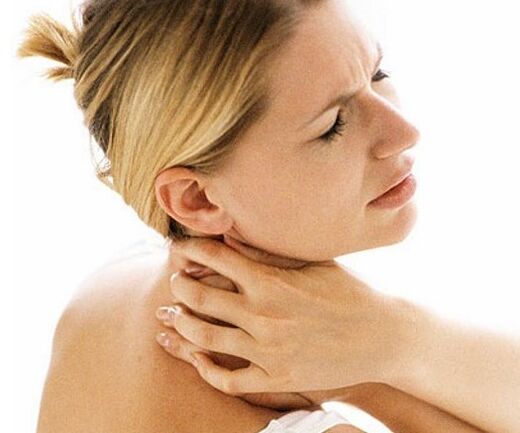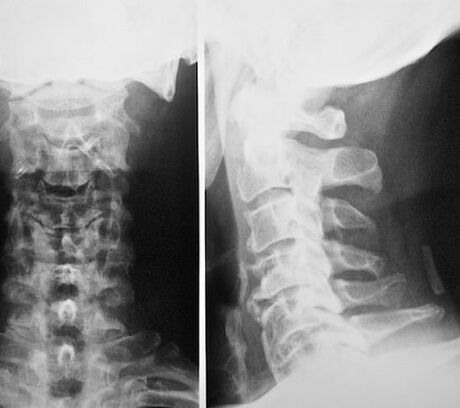Among all the diseases known to humanity, perhaps the most common are diseases of the supporting motor apparatus. There is unlikely to have a person over 40 who would not experience spinal problems, do not complain of joint pain or muscle. The cause of this phenomenon most often becomes a decreased lifestyle, when, with age, with a decrease in motor activity, salts and other harmful substances are deposited in joints that disrupt the functionality of the bone system. It is generally acknowledged that diseases of support and motor oras only appear in people of mature age, but, in recent years, young people are often diagnosed with this type of disease. It is quite difficult to treat such diseases, especially when degeneratively - the dystrophic changes affecting the neighboring cartilage, bones and nerve tissue occur in the tissues. Among a number of diseases that violate the structure of the bone system, a special place is given to a disease such as cervical osteochondrosis, which is considered the most common disease of our time and is found not only in people of mature age but also young people under the age of 35.

Osteochondrosis of the cervical region is a progressive disease, so premature treatment and later the search for a doctor - spina, can lead to human disability. What are these insidious diseases? What are the symptoms of cervical osteochondrosis and how to deal with this disease?
How does cervical osteochondrosis develop?
Cervical osteochondrosis is a progressive disease characterized by degenerative - dystrophic changes in the intervertebral discs that serve deformations, alter their structure, which cause a number of pronounced symptoms. At risk for the development of osteochondrosis of the cervical region are people who lead a sedentary lifestyle or whose professional activity is associated with the body in a long -term position. In terms of osteochondrosis incidence, cervical spine damage ranks second after lumbosacral osteochondrosis. The particularity and complexity of the disease is that the lesion of the cervical region almost always affects the nerve roots of the spinal nerves and intervertebral discs, as a result of which large and small vessels are overcome by blood supply to the brain.
The cervical separation has a complex structure and consists of 7 beads, each of which performs a number of functions: supports the head, turns, bends the neck and other important functions. There are intervertebral discs between the vertebrae, which make the spine flexible and stable, and the intervertebral discs themselves consist of fibrous rings, within which there are pulse nuclei. The cervical vertebrae adapts to each other, which is why even a minor physical activity can cause them to relocate, which in turn causes squeezing of blood vessels and nerves. At the cervical spine are the vertebral arteries that are responsible for the blood supply of the brain. When compressing them, the blood supply is disturbed, the brain does not receive a sufficient amount of life substances, which undoubtedly lead to the loss and development of a number of complications, which can lead to the patient's disability or even death.

The main causes of cervical osteochondrosis
Despite the spread of this disease and achievement in modern medicine, the pathogenesis of osteochondrosis of the cervical spine was not fully studied. It is known that the disease can develop against the backdrop of damaged metabolic processes in the cervical spine, which over time leads to a change in the structure of intervertebral discs and vertebral bodies. Among other types of osteochondrosis, the cervix is more dangerous, as during its development there is a compression of the nerve roots of the spinal cord and blood vessels, which undoubtedly leads to a violation of blood supply to the brain cells. In the pathogenesis of the disease, doctors distinguish several provocative factors that can lead to the development of the disease.
In addition to factors that can lead to the development of cervical osteochondrosis, experts distinguish people who are at risk for the development of this disease.
The reason for the development of cervical osteochondrosis may be other causes, but in any case the disease should be treated in its first signs.
How to know the osteochondrosis of the cervical region and what are its signs?
Clinical signs of cervical osteochondrosis osteochondrosis of the cervical spine develop slowly. Symptoms of the disease depend on the rate and number of damaged vertebrae and pinch of nerve endings. The main symptom of the disease is the pain of different intensity in the spine, neck, lower spine, which are given to other organs. Only one doctor can diagnose "cervical osteochondrosis" after the results of the examination, as the diversity of the disease clinic often resembles other pathologies, but everyone may suspect the disease.

The clinical signs of osteochondrosis of the cervical region are expressed and presented as the disease develops and progresses. Doctors engaged in the treatment of this disease distinguish some osteochondrosis syndromes of the cervix, each of which has its own characteristics, and manifest depending on the damaged nerve spine.

Symptoms of cervical osteochondrosis
Cervical osteochondrosis - symptoms and treatment depend directly on the damaged nerve. The number of cervical roots is 8, and the cervical vertebrae is 7.
If there was a loss of the first and second cervical vertebrae (CI-II), then the sensitivity of the back of the head will worry, which attracts pain in the parietal and occipital region.
Nerve finishing lesion (C3) is extremely rare, yet, when damaged, the patient feels numbness of the neck, in the area where the pinch occurred. Speed, tongue sensitivity is also damaged.
C4 spine lesion causes pain and numbness in the collar or shoulder. Disordisms of the respiratory system, heart pain is observed.
If the vertebral segment of the 5th department is disturbed, then the patient will feel the pain that spreads to the shoulder, the outer surface of the shoulder, the sensitivity of the upper and lower extremities also disturbed.
Pinching the roots of C6 and C7 the most common phenomena among patients. Patients feel pain in the neck, blade, forearm, spine, spine, hands sensitivity, fingers worry.
When the nerve spine is affected, then the pain will spread throughout the neck, back, elbow and give the lower limbs. The numbness of the small fingers in the arms and legs is observed, the sensitivity of the skin are practically missing. The legs and hands of the hands acquire a bluish tinge, due to damaged blood circulation.
In addition to pain syndromes, a patient with cervical osteochondrosis also complains of other diseases described above in the signs of the disease: damaged vision, dizziness, pallor, etc.
Physical media education for osteochondrosis of the cervix
It is necessary to perform and perform physiotherapy exercises only after consulting a doctor. Moreover, movement should discuss any execution with a specialist, as the incorrect position of the neck or limbs can further damage health and worsen treatment. Consider some safe exercises that can and should be performed for patients with cervical osteochondrosis.

Physical physical education is very effective in the treatment of cervical osteochondrosis, but all exercises should be performed regularly and accurately. Of course, the situation does not improve from the first grade, so you need to be patient.
Treatment of osteochondrosis of the cervical department with popular remedies
Traditional medicine has also shown its effectiveness in the treatment of cervical osteochondrosis, which has collected a large number of recipes in its arsenal for decades that will help reduce the symptoms of the disease. The treatment of osteochondrosis with folk remedies is the use of vegetable and animal products for external or internal use.
Recipe 1. Honey from cervical osteochondrosis. You will need 1 - 2 teaspoons of natural bee honey, 2 mummy tablets. Honey and mummy should be heated, wear a warm scarf and join the neck for the night. Honey has a pronounced anti -inflammatory, biostimulating property, so it can perfectly supplement the treatment of this disease.
Recipe 2. Celery from osteochondrosis. 4 - 5 grams of celery should be poured with 1 liter of boiling water, insist 2 - 4 hours, strain and take 1 large tsp 3 times a day.

Recipe 3. A decoction of chamomile and olive oil. You will need 30 grams of chamomile flowers, 0, 5 l of immature olive oil. Chamomile flowers should be poured into oil, wear small fire, bring to a boil and let cool. You should insist a decoction for 2 days, then strain it through complete and rub the diseased areas with the resulting oil. Along with chamomile, other plants can be used: celandine, calendula, St. John's wort. If there is no olive oil in hand, then you can get sunflower.
There are other remedies of traditional medicine that help relieve the symptoms of cervical osteochondrosis. However, it is important to remember that such treatment is effective only at the beginning of the development of the disease and can only be used in complex treatment with traditional methods.
PREVENTION
Prevention of neck osteochondrosis is an active lifestyle. In cases where there is a location for the development of this disease, it is necessary to periodically visit a doctor - orthopedic. No less important place is occupied by food, which should be useful, rich in vitamins, minerals and other useful substances. Preventing or correcting overweight, as well as regular physical exercises, reduce the risk of developing cervical osteochondrosis several times.

















































